Exeter Corporation Tramways
History
The first tramway in Exeter was horse drawn, and was built and operated by the Exeter Tramways Company (see link), the first line opening to the public on the 6th April 1882. The system was always operating on the edge of profitability, and was taken over by a new company in 1892 — the Tramway Purchase Syndicate — which leased operation to a local concern, Frederick Burt and Company, the latter eventually purchasing it in early 1899.
By the turn of the century, the tramway's days were clearly numbered, not only by the advent of the electric tramcar, but by the threat of municipalisation. Under the Tramways Act of 1870, Exeter Corporation had the right to compulsorily purchase the tramway 21 years after the passing of the enablement act, a date that would fall due in 1902.
With the 1902 date looming, the corporation commissioned a report into the tramway, which recommended conversion to electric traction using overhead current collection. In December 1902, the council conducted a public poll to gauge support for an electric tramway, over three-quarters voting for it. The corporation then sought powers to take over operation of the tramway, to convert it to electric traction, and to build extensions to it; these powers were granted on the 1st August 1903 under the Exeter Corporation Tramways Act 1903.
Following arbitration, the tramway, along with five horsecars, several horse buses, and 22 horses, passed into corporation ownership on the 1st February 1904. The horse buses and some of the horses were sold on the 16th February, the corporation concentrating its resources on conversion of the system and operation of the existing horse-tram services.
The last horse-drawn services were withdrawn on the 4th April 1905, the same day that the first electric services commenced (between the Guildhall and Livery Dole, and between St Davids Station and Pinhoe Road). Two weeks later (on the 29th April), the line beyond Livery Dole to Cross Park Terrace was opened, as well as the line from the Guildhall to a terminus on Cowick Road. The latter line had required a new bridge over the River Exe, which was specifically designed to carry the new tram tracks. These newly instituted services were worked by 12 tramcars, which were quickly followed by another two.
On 22nd September 1906, services commenced over the last new line to be built, along Alphington Road, six more tramcars arriving to work them. This took the 3ft 6ins-gauge overhead electric tramway system to its final size of 4.95 miles. From High Street, lines ran northwestwards to the GWR railway station at St Davids (via Queen Street, Hele Road, and St Davids Hill); northeastwards to Sidwell Street, whereupon the lines split, one continuing northeastwards to a terminus at the junction of Pinhoe Road with Abbey Road (via Bath Road, now Blackboy Road), the other heading eastwards to a terminus at the junction of Fore Street and Cross Park Terrace (via Paris Street and Heavitree Road); and southwestwards via New Bridge Street and over the River Exe, whereupon the lines split, one continuing southwestwards to a terminus at the junction of Cowick Street and Buddle Lane, the other heading southwards to a terminus at the junction of Alphington Road and Stone Lane (via Alphington Street).
Although the council held powers for further lines, and extensions to the system were often proposed, none, other than minor changes, were ever constructed.
The tramway appears to have been well patronised, and was almost certainly profitable, though financial details remain to be researched. The council, however, appears to have used the profits to subsidise the rates rather than building up a reserve/sinking fund for renewals, which meant that it was often reluctant to sanction significant expenditure as this would require it to borrow money or make cuts elsewhere.
As with most tramways in the British Isles, Exeter's suffered during the Great War from a loss of skilled men to the armed services, and restrictions on spares and new materials. Maintenance of the system was inevitably kept to the bare minimum, and at a time of greatly increased passenger loadings; the corporation was, however, fortunate in having purchased four new tramcars in 1914, which arrived in August that year.
Following the end of the conflict, the manager placed a report before the Tramways Committee, which detailed the significant expenditure that would be needed to set the system in good order. The council not unnaturally baulked at the large sums involved (presumably having no reserve fund), and tried in 1921 to divest itself of the system by offering it to a commercial tramway operator — the National Electric Construction Company — which tactfully declined to take over a run-down system. Later that year the council finally bit the bullet, and authorised an extensive but phased programme of tramcar rebuilding, and track and overhead wire replacement.
Two new tramcars were purchased in 1921, three in 1925 and four in 1926. These were followed in September 1928 by a further four vehicles, the council having acquired powers on the 2nd July 1928 (under the Exeter Corporation Act, 1928) to build an extension of the Pinhoe Road line out to Whipten, as well as to run motorbuses. The trams were duly joined by seven buses on the 1st April 1929; they initially provided services to areas that the trams did not serve.
By this time, however, the council was greatly troubled by the serious traffic congestion within the city's narrow streets, and was having to deal with a significant faction within the council that thought the trams should be scrapped. After much vacillation, the Tramways Committee decided to commission an independent report — from the manager of Sheffield Corporation Tramways, Mr A R Fearnley — on its options moving forward. The report made for sober reading, not only was significant expenditure required, but in the author's opinion, the city's streets were fundamentally unsuited to tramway operation, and they should be scrapped and replaced by motorbuses. Furthermore, the expenditure required to build the Whipten extension, for which the corporation had already acquired new trams, could not be justified.
The Tramways Committee evidently did not like the report's conclusions, so watered-down them down in its recommendation to the council, seeking to continue tramway operation for at least three years, and even to build a portion of the Whipten extension. However, by the 3rd December 1929, the Tramways Committee was faced with a newly elected council, and one which completely rejected their proposals. The committee now had to bite the bullet, and in July 1930 it recommended that the tramway be abandoned as soon as practicable, and that the services be replaced by motorbuses; the recommendation was endorsed by the full council shortly afterwards.
The first closure was the Alphington Road line, whose track was life expired, and which was cut back to Alphington Street on the 1st January 1931. In March 1931, the four newest tramcars were sold to Halifax Corporation Tramways, and in the following July and August, the new motorbuses that would enable the system to be closed, arrived.
Tram services were cut back in early August as the new motorbuses were deployed, the last tram running on the 19th August 1931.
Uniforms
Exeter Corporation took over the horse tramway on the 1st February 1904, operating it for 14 months. Although photographs of the horse tramway taken prior to 1904 are very rare, a surprising number appear to have been taken during the relatively short period of municipal operation, up until electrification (circa 14 months later in early April 1905). These photos clearly show that tramcar crews were provided with smart new uniforms — in stark contrast to the policy of the previous owner/operator — whose uniform expenditure only appears to have stretched to the issuing of kepi-style caps to conductors (see link).
Corporation horse tram drivers and conductors were issued with double-breasted, lancer-style tunics with five pairs of buttons (presumably brass, and bearing the full title and corporation device — see link), and with stand-up collars; photographs suggest that insignia were carried on the latter, very possibly the system initials and employee numbers seen in photos taken during the electric era (see later). The drooping-peak caps bore a large municipal-device badge, almost certainly the same pattern as the brass example depicted below; these badges comprised a shield, helmet, crest and supporters, above a ribbon containing the city motto, 'SEMPER FIDELIS'. Tramcar crews were also provided with long double-breasted greatcoats; these appear to have carried some form of badge on the epaulettes, possibly an employee number.
Photographs taken on the opening day of electric services show staff wearing double-breasted, lancer-style tunics with five buttons (narrowing from top to bottom), two waist pockets, epaulettes (with button fastening) and stand-up collars. The latter carried an employee number in individual numerals on the bearer's left-hand side, and individual metal initials, 'E C T', on the right, all presumably in brass. The horsecar crew drooping-peak caps were replaced by tensioned-crown peaked caps; the cap badge remained unchanged. At some point, probably just after the Great War, a new style of single-breasted jacket was introduced with five buttons, waist and breast pockets, epaulettes and stand-up collars; the latter continued to carry the same designations as the earlier tunics. Photographs frequently show crews with both styles of uniform, suggesting that their introduction was a gradual process.
At the very end of the tramway era, another change was made to the style of the uniform, this time to a more modern double-breasted jacket with three pairs of buttons, and lapels; the jacket collars carried the same insignia as the older uniforms. These new uniforms very probably bore chrome insignia and buttons, as Exeter Corporation Tramways buttons exist in this material, despite the fact that chromium plating only came into vogue in the very late 1920s (see link), and was expensive — somewhat surprising given that the system was closed in 1931.
Inspectors in the municipal horse tramway-era probably wore single-breasted jackets with lapels, shirt and tie (the surviving photographs are unclear), along with long double-breasted overcoats with lapels. In contrast to the tramcar crews, their peaked caps had an unusually wide crown; they bore the same pattern of municipal-device badge that was used on tramcar crew caps. By the tram of electrification, inspectors were wearing single-breasted jackets with hidden buttons (or more likely hook and eye fasteners) and stand-up collars, along with tensioned-crown peaked caps bearing the standard municipal-device cap badge. It is currently unclear what insignia were carried on the jacket collars.
A staff photograph taken after the demise of the tramway (see below) shows that in the 1930s, inspectors wore very similar jackets to bus crews, but with the grade — 'Inspector' — in embroidered script-lettering on the collars. The tensioned-crown peaked caps carried the standard municipal-device cap badge. It is likely that these uniforms and caps were the same as those used during the last few years of the tramway's life.
During the Great War, the corporation initially employed young lads strait from school to replace male staff lost to the armed services. It was, however, not long before female staff were taken on, though only as conductresses. Unfortunately, no photographs of these ladies appear to have survived, so it is currently impossible to state what uniforms they wore.
Further reading
For a history of Exeter's horse tramway, see: 'Exeter: a Century of Public Transport' by R C Sambourne; Glasney Press (1976). For a pictorial history of Exeter's tramways, see: Exeter and Taunton Tramways' by J Perkin; Middleton Press (1994).
Images
Horse tram drivers and conductors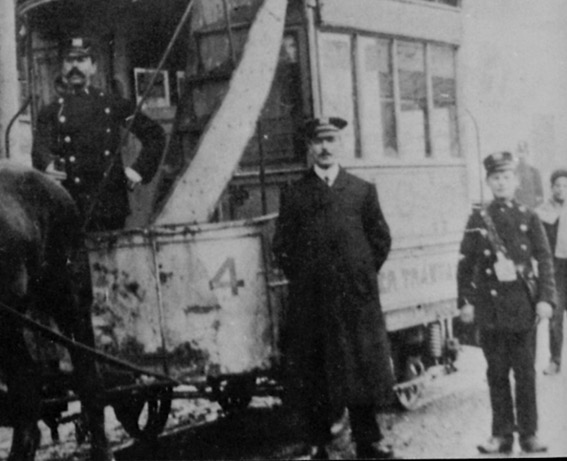
A rather battered Horsecar No 4 outside Polsloe Park Post Office in the corporation era — photo undated, but certainly taken in 1904 or early 1905. The prominent municipal cap badge is clearly evident on the driver (left), the inspector (centre) and the conductor (right). Photo courtesy of the Tramways and Light Railway Society, with thanks to David Voice.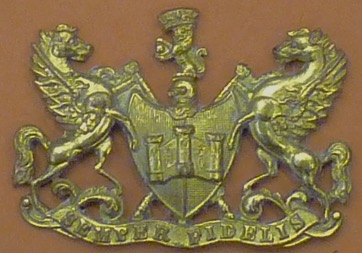
Exeter municipal-device cap badge — brass. This was used on Exeter Corporation Tramways staff caps throughout the 27-year life of the municipal tramway. With thanks to John Burford.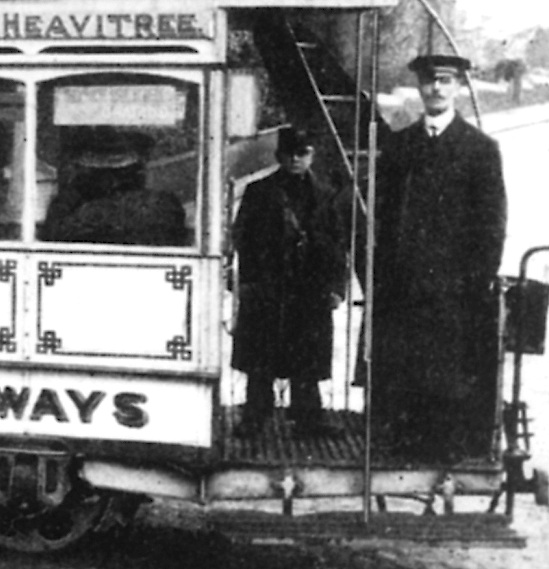
Horse Car No 3 in Heavitree Rd, and still in Exeter Tramways livery — photo tentatively dated to 1905, though certainly taken in the corporation-era. The larger figure to the right is presumably an inspector, and in all probability, he is the same individual depicted in the photo of Horsecar No 4 above. Photo courtesy of the Tramways and Light Railway Society, with thanks to David Voice.
Motormen and conductors
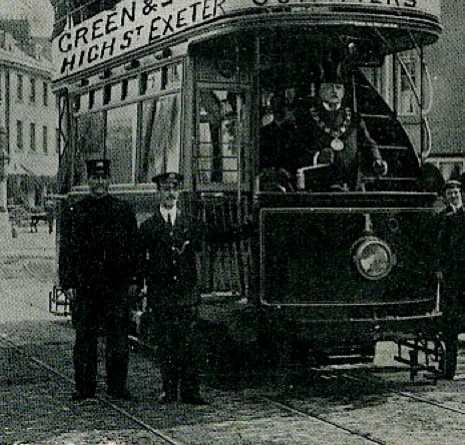
A photograph purportedly taken on the opening day of electric services — Tuesday 4th April 1905 — with Mayor E C Perry at the tramcar controls. The man on the left is presumably a new electric-tram inspector, whereas the man in the middle, who is also likely to be an inspector, is probably wearing the uniform issued to inspectors during horse-tram only operation. Photo courtesy of the Tramways and Light Railway Society, with thanks to David Voice.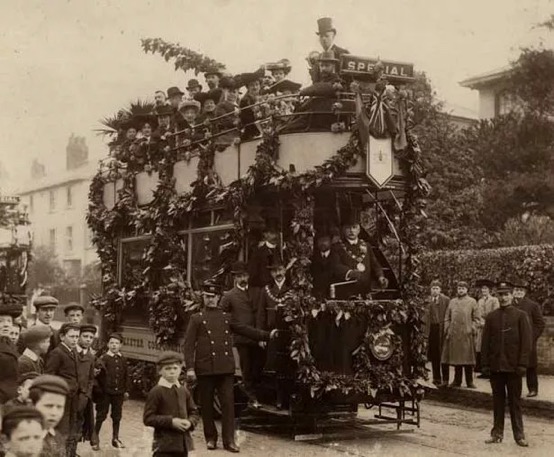
A photograph that was definitely taken on the opening day, again with the mayor at the controls. In this shot, the tramcar is decorated, and the motorman is wearing a lancer-style jacket.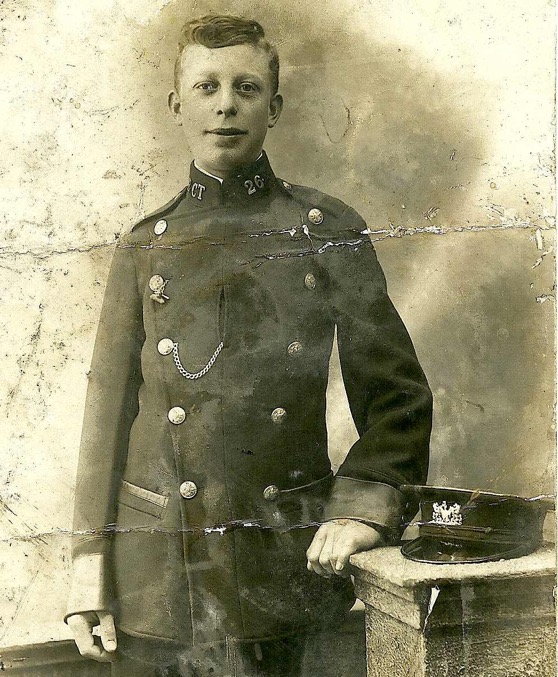
An excellent studio portrait of Exeter Corporation Tramways Employee No 26 — photo undated, but probably taken shortly before to the Great War. The collar designations and the cap badge are particularly clear. Photo courtesy of the Stephen Howarth Collection.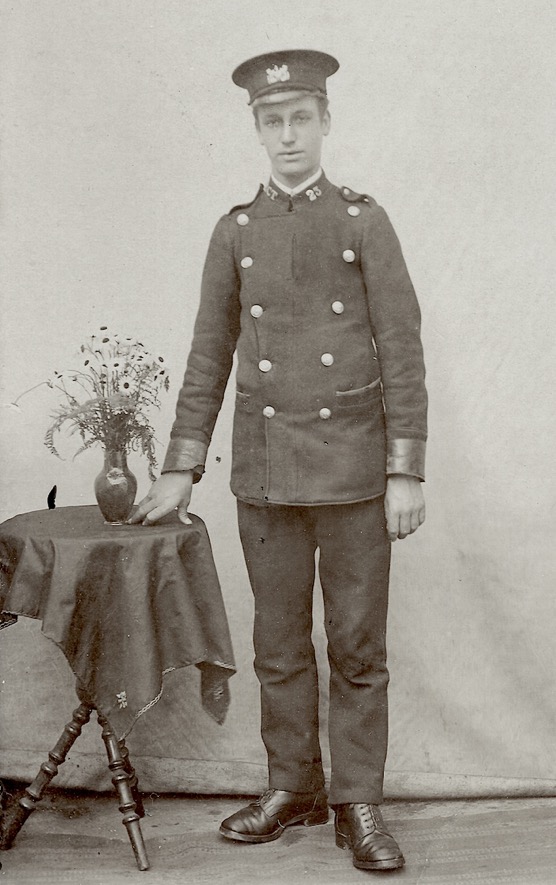
Another studio portrait of an ECT tramwayman, this time Employee No 23 — photo undated, but probably taken shortly before the Great War. Photo courtesy of the Stephen Howarth Collection.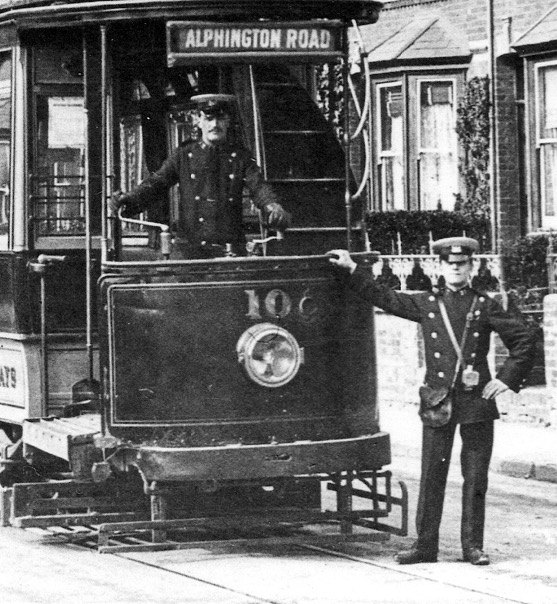
A motorman and a conductor pose with Tramcar No 10 in Alphington Road — photo undated, but almost certainly taken shortly before the Great War. Both men are wearing double-breasted, lancer-style tunics, as well as what would appear to be straw-topped peaked caps, indicating that it was summer.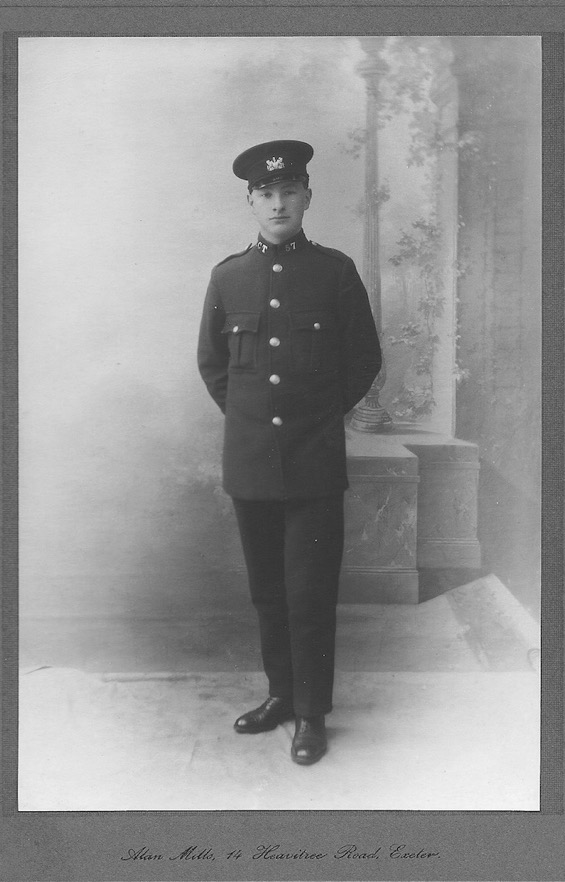
A lovely studio portrait of Exeter Corporation Tramways conductor Gilbert Easterbrooke — photo probably taken around 1920. Mr Easterbrooke started as a tram conductor, later became a motorman, then worked on the buses, initially as one of the first corporation drivers, finally retiring as an inspector. Photograph by kind permission of his daughter, Margaret Batten.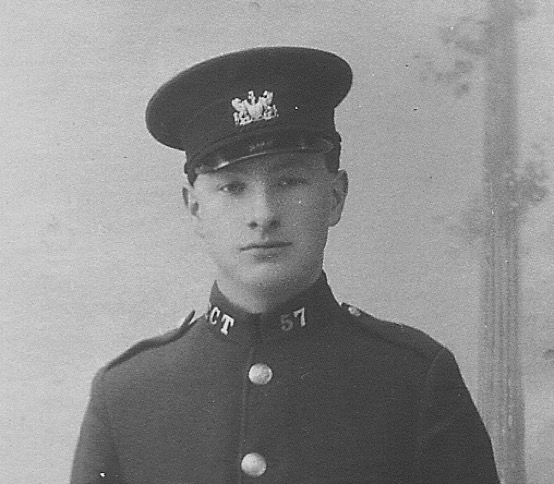
An enlargement of the above photograph showing the cap badge and collar insignia, revealing that Mr Easterbrooke was Employee No 57.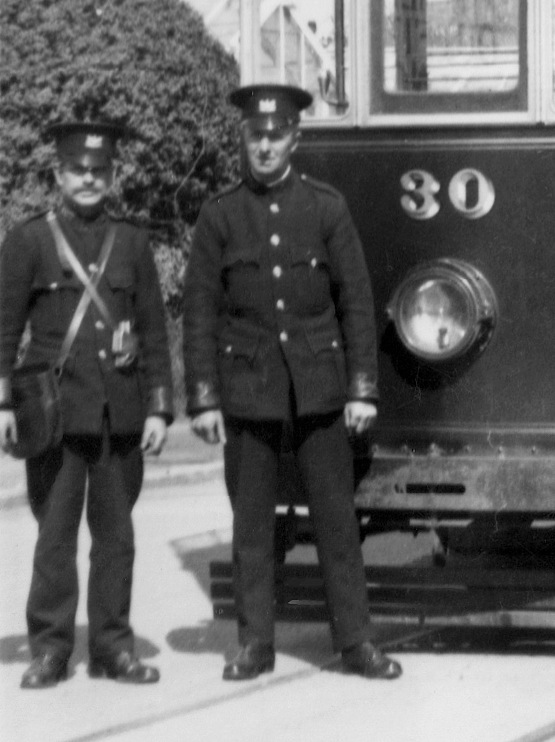
A conductor and a motorman stand in front of Tramcar No 30 at the Stone Lane terminus — photo undated, but definitely taken after 1925 as No 30 was not built until then. Both men are wearing single-breasted jackets with epaulettes.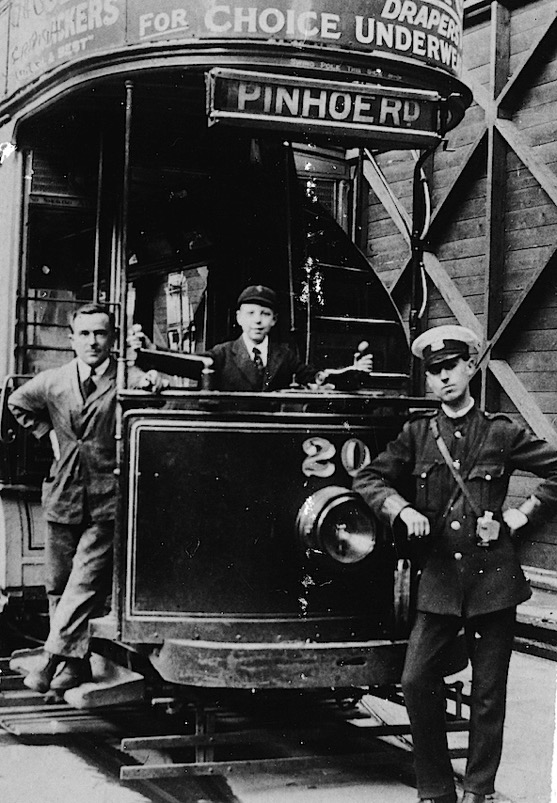
A conductor leans casually against Tramcar No 20's headlamp, along with a fitter and a no doubt rather excited schoolboy, inside Heavitree depot — photo undated, but probably taken in the mid-to-late 1920s. With thanks to the National Tramway Museum. 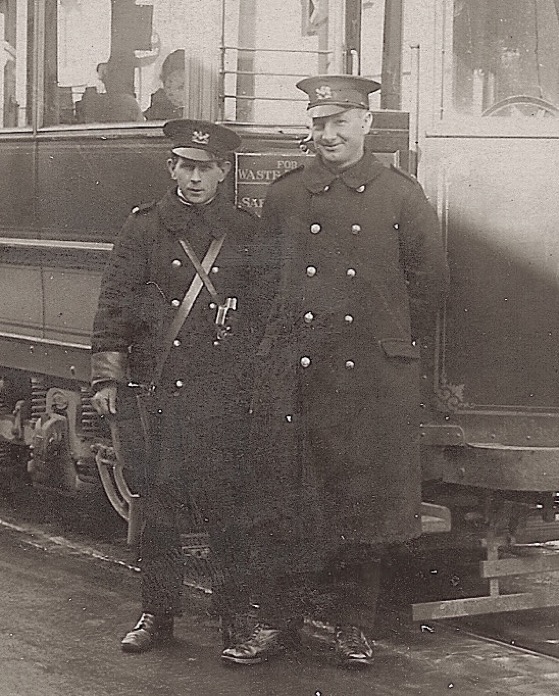
Another shot of Gilbert Easterbrooke (right), this time as a motorman, along with his conductor and Tramcar No 24 — photo undated, but almost certainly taken in the very late 1920s or early 1930s. Photograph by kind permission of his daughter, Margaret Batten.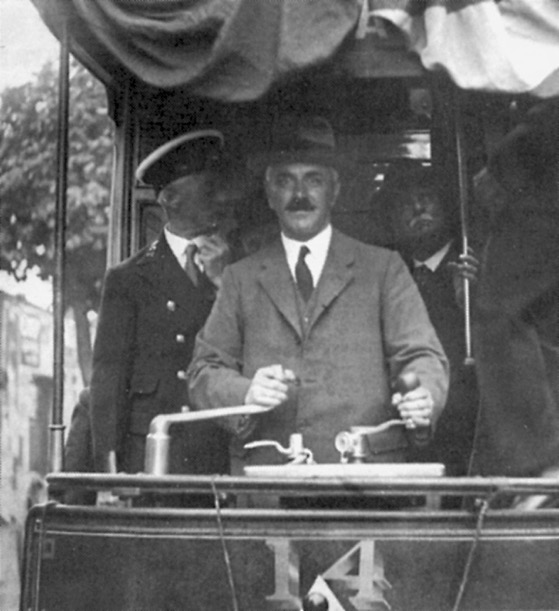
Mr H E Bradley (Chairman of the Transport Committee) at the controls of the last tram on 19th August 1931. Note that the tramwayman to his right (Motorman Nicholls) is wearing a smart new style of double-breasted jacket with wide lapels. Photo courtesy of the Tramways and Light Railway Society, with thanks to David Voice.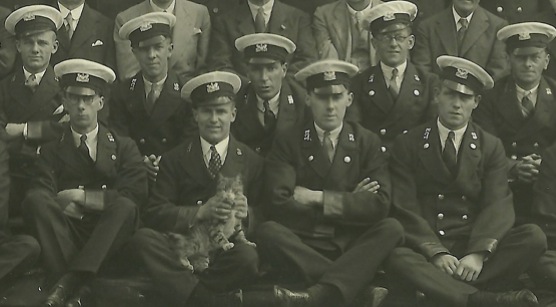
A close-up taken from a much larger photo of Exeter Corporation Transport staff outside a municipal depot. Although it was almost certainly taken several years after the demise of the tramway, the uniforms appear to be similar in style, if not identical to the one seen in the last-day photograph above. With thanks to Stephen Howarth. 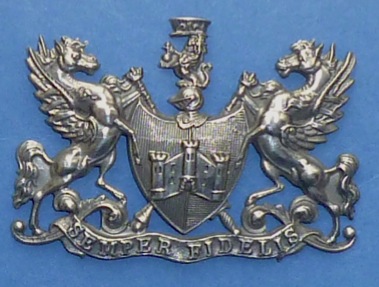
Exeter municipal-device cap badge — nickel. Whilst badges in this material may have potentially been worn during the tramway era, the fact that Exeter Corporation Tramways buttons are unknown in this material suggests that it was used by another corporation department. Author's Collection.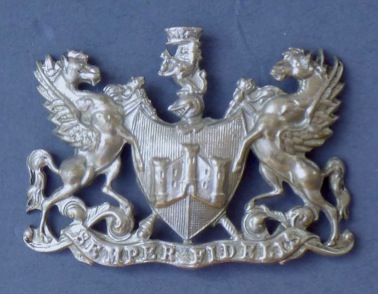
Exeter municipal-device cap badge — chrome. As Exeter Corporation Tramways buttons have survived in this material, it is possible that chrome insignia were also worn late in the tramway era. Author's Collection.
Senior staff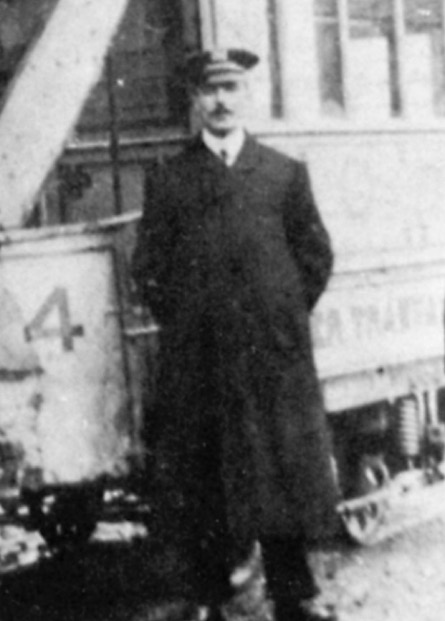
An enlargement of the photograph of Horsecar No 4 above (taken in 1904 or 1905), showing a figure who is presumably an inspector. He appears to be wearing a standard Exeter municipal-device cap badge on his wide-crown peaked cap.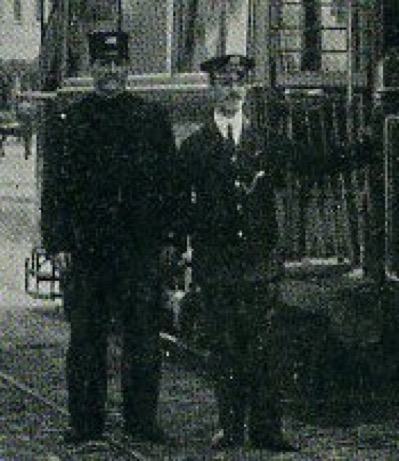
An enlargement of the opening day photograph above, again showing a figure who is, in all probability, an inspector. He is wearing a single-breasted jacket with lapels, and like the photograph above, a wide-crown peaked cap rather than the drooping-peak caps that were worn by horse-tram crews.
An enlargement of a larger Exeter Corporation Transport-era photograph, showing an inspector. Although taken after the demise of the tramway, it seems likely that the uniforms were the same as worn by inspectors in the latter days of the tramway (i.e., the 1920s).